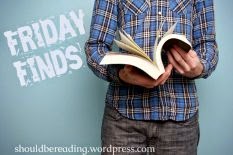Hosted by MizB. Click on the picture to link up!
It's Friday, and just one more reason it's a good day is linking up to Friday Finds. I'm so excited about the books I've been finding lately.
When I read Destiny of the Republic recently, I was introduced to the period of time when antiseptic surgery was not yet the norm. Many thought it was ridiculous and many doctors hastened death in their patience because of their prejudice. Dr. Mutter's Marvels is the biography of a doctor who accepted the practice, and it sounds fascinating.
I'm reading Some Luck by Jane Smiley this week, and I'm loving it so much I've added her Pulitzer Prize-winning A Thousand Acres to my TBR list. I remember watching the movie based on the book when it came out and not liking it much (but then, it's my personal opinion that Michelle Pfeiffer ruined pretty much every movie she ever landed), and I've never read King Lear, but if this is half as good as her newest novel, I'm all in.
The Good Son is a biography of JFK Jr., specifically his relationship with his mother.
As for some heavy history...
In the Heart of the Sea is the story of the whaleship Essex (which inspired Moby-Dick), and if it's anything like In the Kingdom of Ice (one of my favorite books of the year), I think I'll enjoy it a lot.
While I was checking out In the Heart of the Sea, I ran across another of Nathaniel Philbrick's books, Mayflower. Should be a fascinating read.
With In the Kingdom of Ice, Hampton Sides made a fan for life here, so I've added his Ghost Soldiers to my list, too. But Unbroken was enough World War II POW story for me for awhile, so I don't think I'll be dipping in this one soon.
And for some eye and brain candy...
Novel Interiors, due out Dec. 2, is a decorating book full of interior designs based on books (Austen, Bronte, Wharton, etc.). Combining two of my passions, books and interior design. Sigh.
By the Book: Writers on Literature and the Literary Life from the New York Times Book Review is a series of interviews with contemporary authors. Although I'm sure not to know most of the writers, it doesn't really matter to me. I love to hear anyone talk about books.
Whew, that was quite a list. What have you added this week?








































